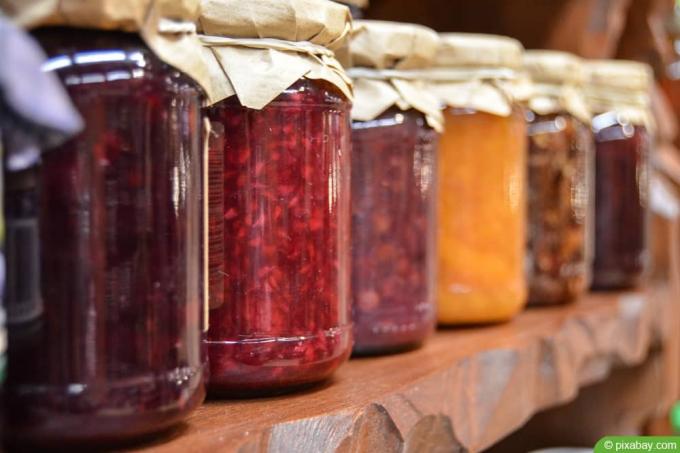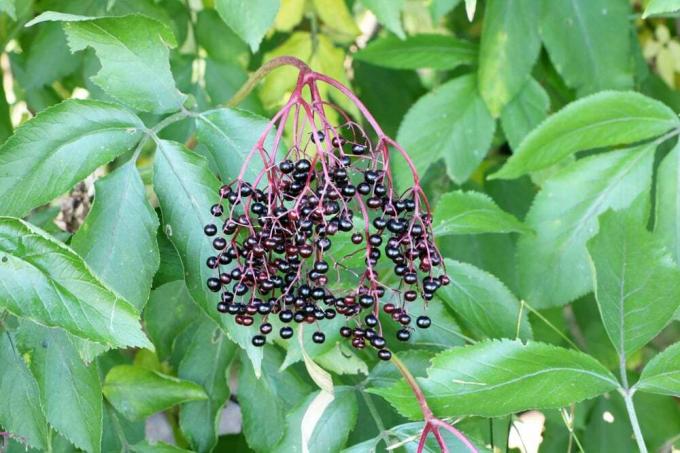

Table of contents
- Prepare and juice the quinces
- Cook quince jelly
- Quince jelly without jam sugar
Are you lucky enough to have a quince tree in your garden? Quinces not only have a particularly fine taste (it's not for nothing that they belong to the rose family), they also contain a lot of healthy things:
Vitamin C, Potassium, Sodium, Zinc, Iron, Copper, Manganese and Fluorine. In addition, quinces contain tannins, tannic acid, organic acids and a lot of pectin, the latter is interesting for the preparation. Unfortunately, you cannot eat the fruits of the quince trees native to Germany raw, they are too hard and also bitter due to the tannins they contain. So if your quince tree produces a bounty in late fall, these fruits must be processed somehow. Quince jelly is very popular, so it works well and easily:
Prepare and juice the quinces
Before processing, the fluff (fur) of the quince must be thoroughly rubbed off with a sturdy cloth, as it contains plenty of bitter substances. This can be done faster with a finer and rather soft wire brush, as these leave fine scratches on the surface skin, this procedure is only recommended if the quinces are processed further immediately become.
Then quinces are washed, roughly diced and placed in a pot. Just cover the quinces with water and bring to a boil, covered. Now the quinces are allowed to cook for about 45 minutes at a medium temperature until soft. Then the mass is sieved through a cloth, if the jelly should remain completely clear, very carefully without pressing. Lemon juice is now added to the quince juice to taste, often the juice of one lemon is added to one kilogram of quinces.
Juicing also works with the steam juicer. A little water is put into the pot, the drip tray without holes is placed in it and catches the juice. The perforated bowl is placed over the unperforated bowl and filled with the chopped quinces. Then juice according to the instructions, quinces will need some time. Our quinces are probably too hard for the normal juicer, they could damage the blades.
Cook quince jelly
Measure the juice and add half its weight of jam sugar. Spices to taste, such as a sprig of lemon balm, are now added. The liquid is brought to the boil while stirring and then has to boil for about 2 minutes. The spices are removed and the quince jelly is immediately filled into twist-off glasses. Then pull the cling film through high-proof alcohol and place it on the jars, screw on the lid and turn the jelly upside down for a few minutes.
Quince jelly without jam sugar
If you harvest the quinces in time so that they still contain enough pectin but are not too unripe, it should work. The ideal time should be when the quinces are just turning from green to yellow. Then don't add jam sugar to the juice, only sugar to taste. The pectin in the quinces is said to gel entirely without sugar, perhaps an idea for a jelly that is an unusual addition to meat? Maybe refined with some spices? You can check whether the quinces release enough pectin with the gelling test: put some of the mixture on a chilled saucer, the mixture should then be thick. If it is not, you can either continue cooking or add preserving sugar.
A very tasty and healthy quince bread can be made from the soft-boiled quinces that are left over after boiling. If you intend to do this, you should cut out the stalk, flower and seeds when washing so that the pure pulp remains.
 garden editorial
garden editorial I write about everything that interests me in my garden.
Learn more about jams

Jam Labels: Free Labels & Vintage Templates
A jam jar looks much better with a pretty label. Whether you want to give it away or keep it for yourself, with a lovingly designed label, the jam in the jar looks even better. At the same time you know what is in the container and when it was boiled down. Something like that is also extremely important.

Thicken cherries: how to do it | Cornflour, cake glaze & Co
Thickened cherries are a fine treat that can be added to all kinds of dishes. The expert explains what to look out for when thickening cherries, how to proceed and which cherries are best suited.

Cooking elderberry jam: recipes
A fruity and delicate jam can be made from elderberries, which is ideal as a sweet spread for breakfast or a snack. The berries, which grow wild in many places, are also suitable for making jelly, which scores with a particularly creamy taste.

Jam jar label ideas
A hobby gardener not only enjoys his well-kept garden paradise, but above all the fruits of his labor in the form of fresh fruit and berries. Jams are a popular way of using the harvested crop.

Make elderflower jam yourself
How often do we look forward to late spring or the beginning of summer about the splendor of white flowers with which the elder delights us. If you don't want to wait for the ripe berries, you can also use the flowers to make jam.

Make elderberry jam yourself
Elder trees and shrubs are common. They are not only at home in our gardens, they also grow in large numbers in the wild. The flowers, fruits and berries of the elder are popular. Learn more about recycling.
